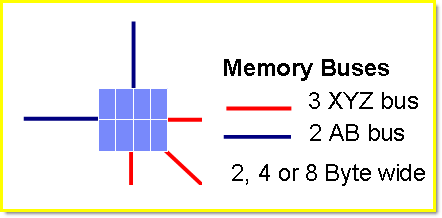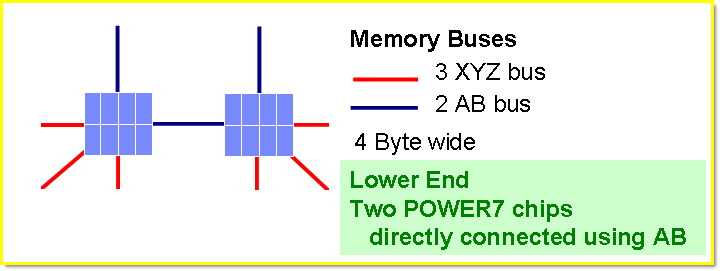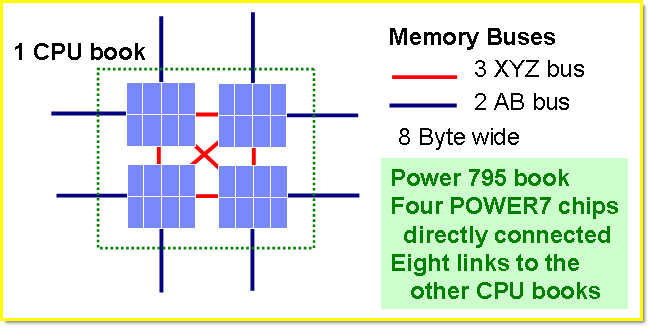How To
Summary
Power Systems gain their massive performance with lots a technology this series details many of them.
Objective
Originally, written in 2012 for the DeveloperWorks AIXpert Blog for POWER7 but updated in 2019 for POWER8 and POWER9.
Steps
I have been wondering why the lower end POWER servers have local and far memory and not local and near. Perhaps you wondered too! Well at the Miami Power Technical University, I got to talk to Dr Joel Tendler (IBMer) and a POWER processor guru and put the question to him. He covered this sort of architectural topic in his presentation at the event and I learnt a lot in this area by listening to the "expert". Below is some background and the explanation too.
As we have covered in this series, sometimes the memory is not local but connected to a different POWER chip. When a process (program) has to access non local memory it needs to first check it is not cached somewhere and if not, read it from the POWER chip that has the memory controller for the RAM. At the Technical University, I also attended a session from Jeff Stuecheli on POWER Cache Coherence i.e. the protocols for determining the best (meaning up to date) copy of a cache line, how to lock it for write access and how to ensure the update gets back to the memory - he is the chief memory architect and designer. Well, I can't say I understood much of it (may be 10%) as it was advanced deep stuff but the impressions I got was "it is way more complicated than I thought but we really have loads of clever people working on the world leading technology. It explains how we get to 256 way machines with good performance". Perhaps, I will go to his session again in the next Technical University and try to remember 20% of it this time :-)
On a practical side, each POWER has what is called a fabric bus controller (FBC) built into the chip, which is used to communicate with other POWER chips for control (finding cache lines and access modes) and for transport (moving the cache line to the POWER needing it).
If you want to know more and want a diagram, take a look at the Redbooks that IBM produces for each Power Server model.
Briefly, there are five fabric ports, which can be configured for 8-byte, 4-byte or 2-byte width. The five fabric ports are grouped in to
- XYZ bus - up to three fabric port connections (hence three letters)
- These are only used in the Enterprise server models like Power 780/780/795, E880 and E980 to directly connect each POWER processor in the same CEC drawer.
- AB bus - up to two fabric port connections (hence two letters)
- These are used by lower end models for POWER chip to POWER chip connections
- In the large Enterprise servers Power 780/780/795, E880 and E980 these are use to connect the four CEC drawers.
In diagram form, a single POWER chip has five buses as below:

Lower End machines are connected using the AB bus as in the following diagram as you can imagine the configuration easily enough:

The High End machines per CEC Drawer are connected as in the following diagram:

I am also told the lower POWER model machines use the 4-byte bus width. This is largely because with only a few POWER chips (one or two) the higher bandwidth is not required and there much fewer remote processors. It also means fewer tracks across system planar (motherboard). I guess this also controls costs and complexity (better reliability).
On the top end machines, the chances of remote processors grows exponentially, they have the full 8-byte buses and the two tiers (XYZ plus AB) to maximise the bandwidth and this explains the excellent scaling we have on the top end machines - in addition to double the number of memory controllers per POWER chip.
Additional Information
Other places to find content from Nigel Griffiths IBM (retired)
Document Location
Worldwide
[{"Business Unit":{"code":"BU058","label":"IBM Infrastructure w\/TPS"},"Product":{"code":"SWG10","label":"AIX"},"Component":"","Platform":[{"code":"PF002","label":"AIX"}],"Version":"All Versions","Edition":"","Line of Business":{"code":"LOB08","label":"Cognitive Systems"}},{"Business Unit":{"code":"BU054","label":"Systems w\/TPS"},"Product":{"code":"HW1W1","label":"Power -\u003EPowerLinux"},"Component":"","Platform":[{"code":"PF016","label":"Linux"}],"Version":"All Versions","Edition":"","Line of Business":{"code":"","label":""}},{"Business Unit":{"code":"BU058","label":"IBM Infrastructure w\/TPS"},"Product":{"code":"SWG60","label":"IBM i"},"Component":"","Platform":[{"code":"PF012","label":"IBM i"}],"Version":"All Versions","Edition":"","Line of Business":{"code":"LOB57","label":"Power"}}]
Was this topic helpful?
Document Information
Modified date:
03 July 2023
UID
ibm11126737
